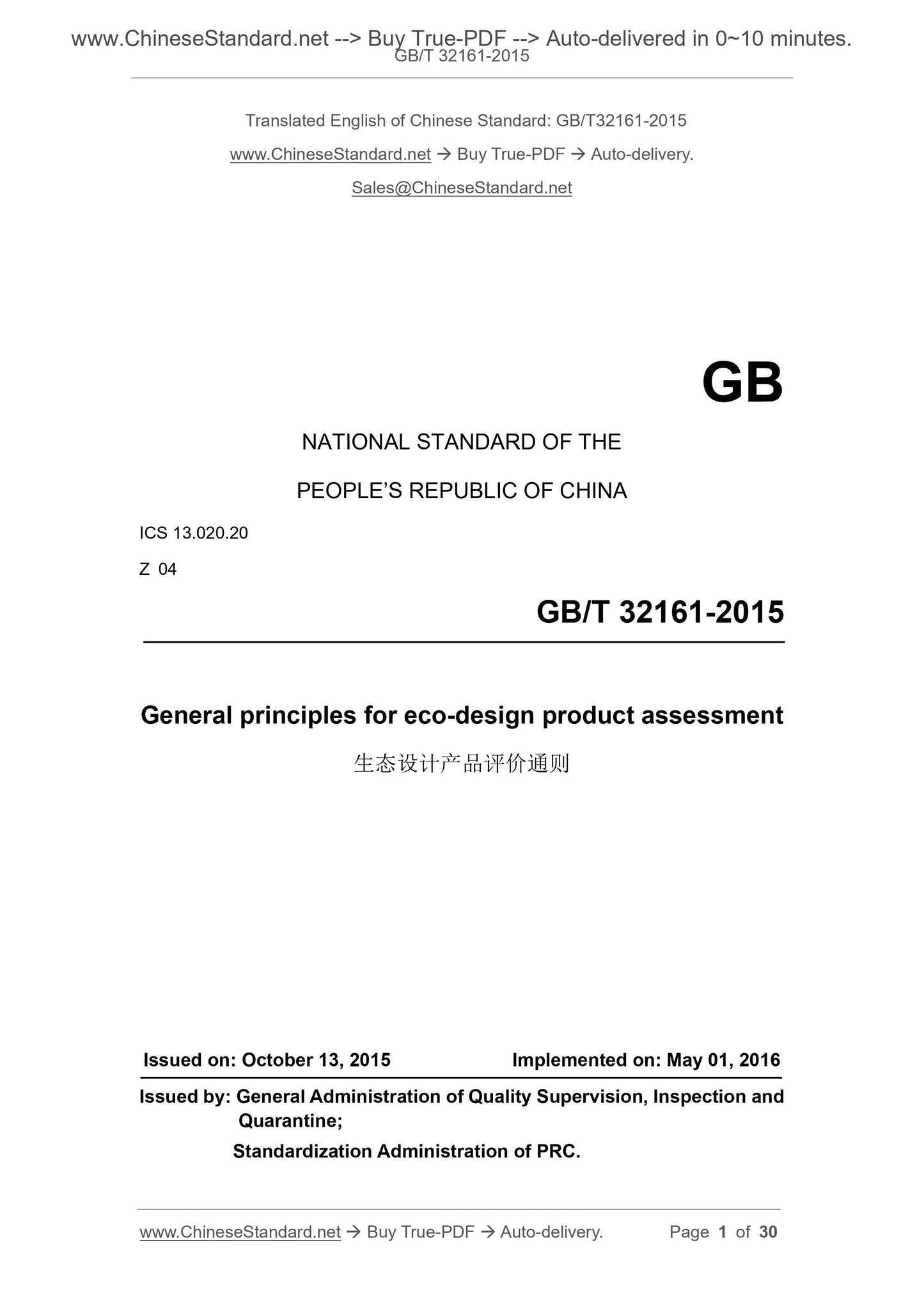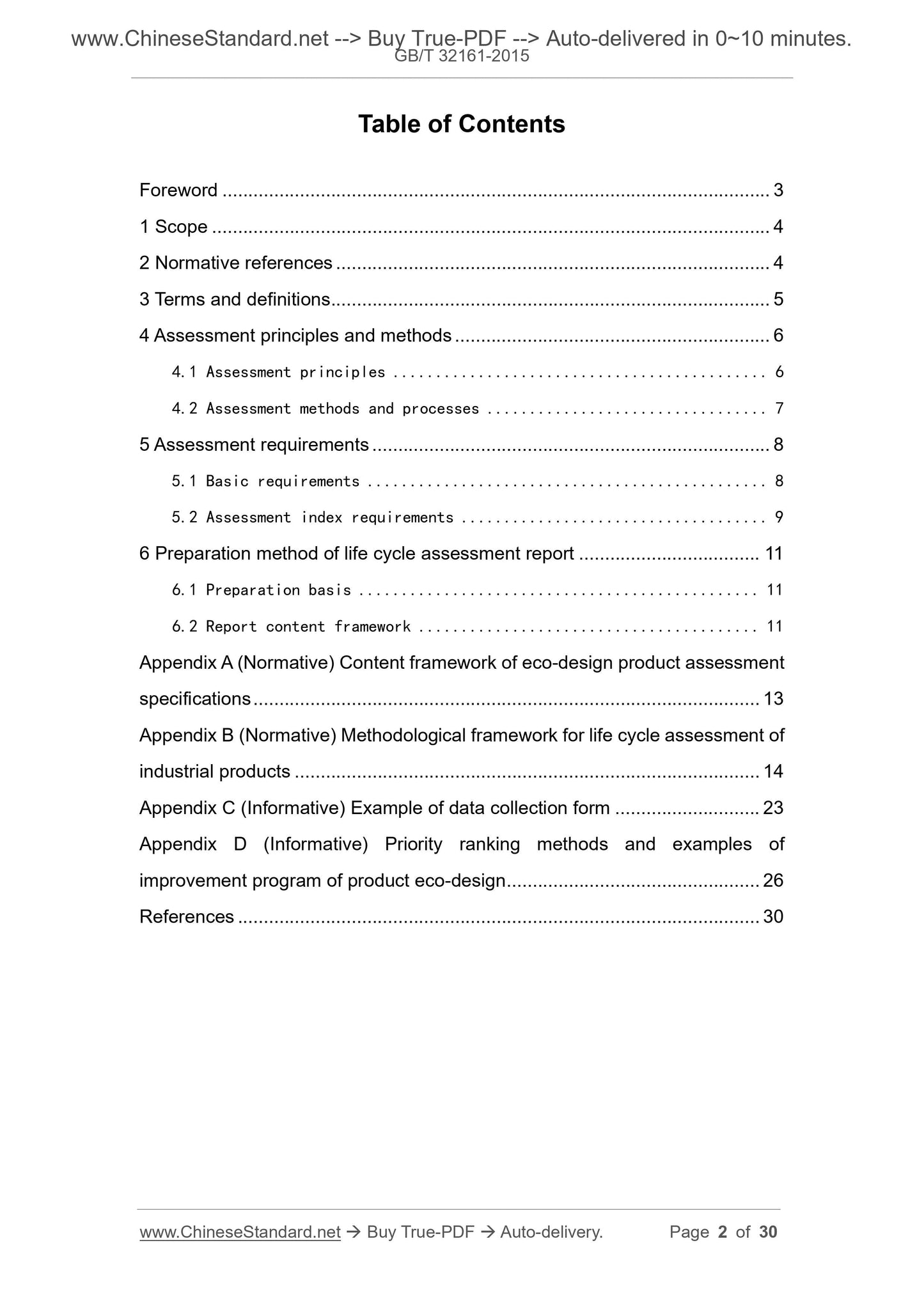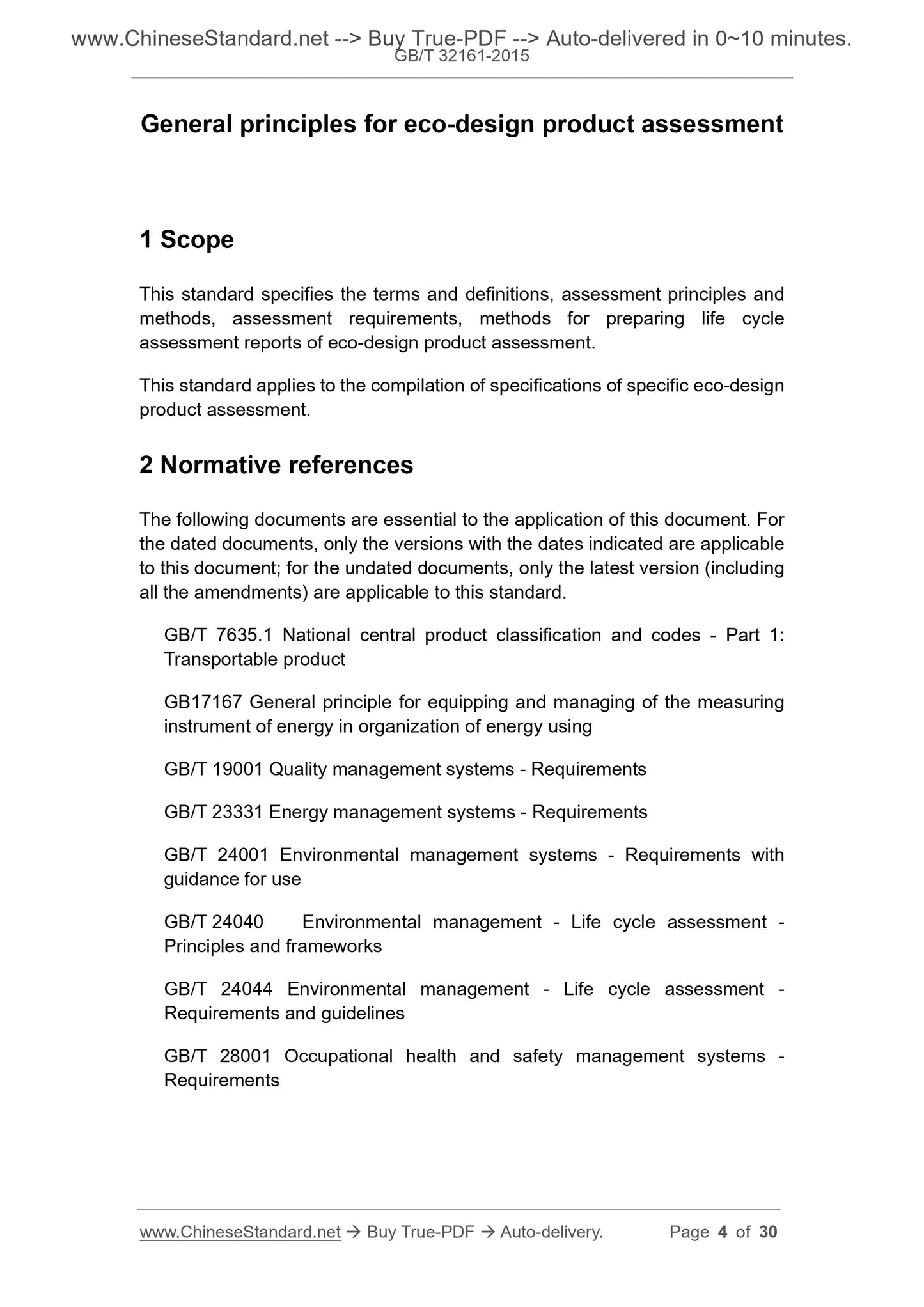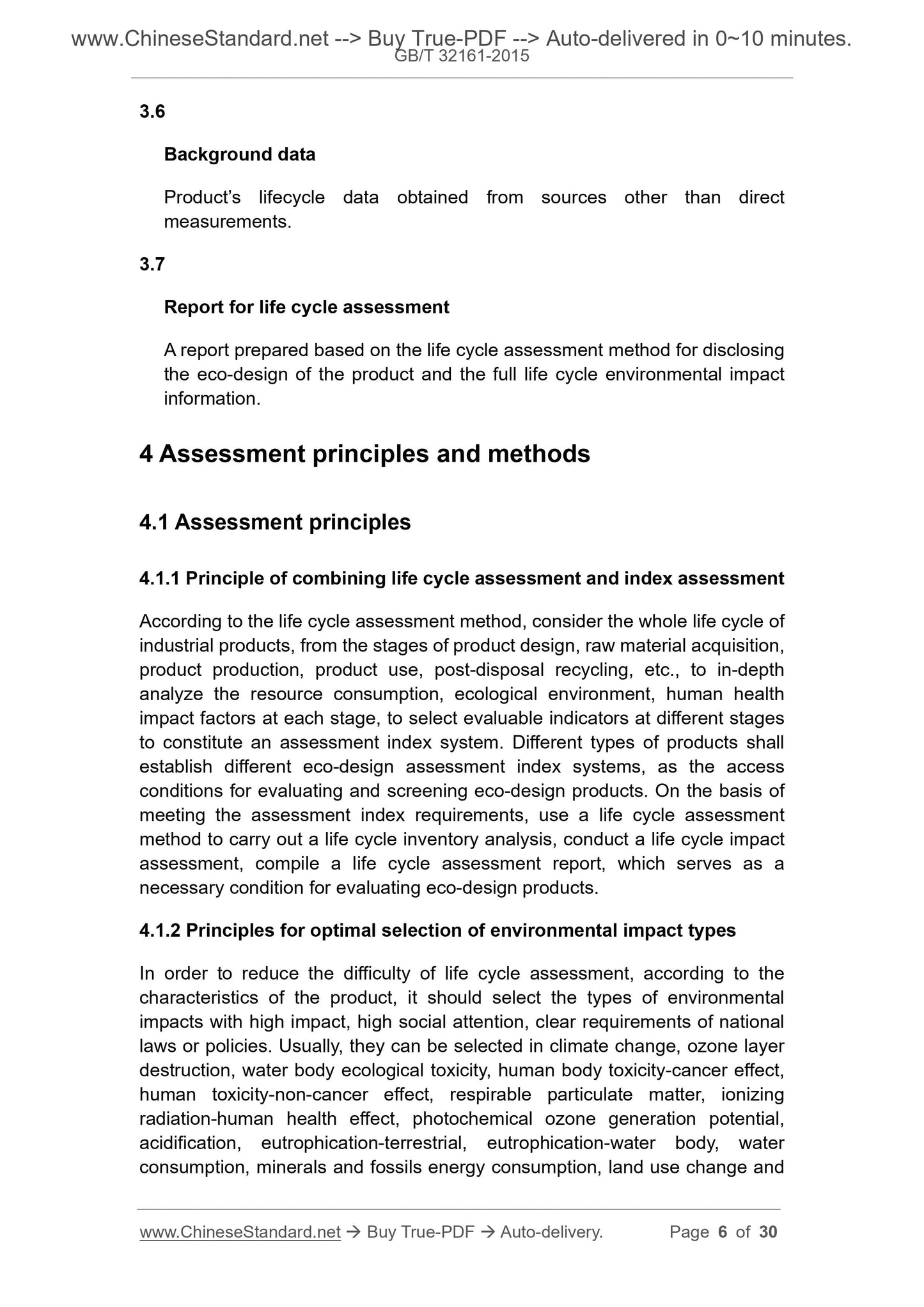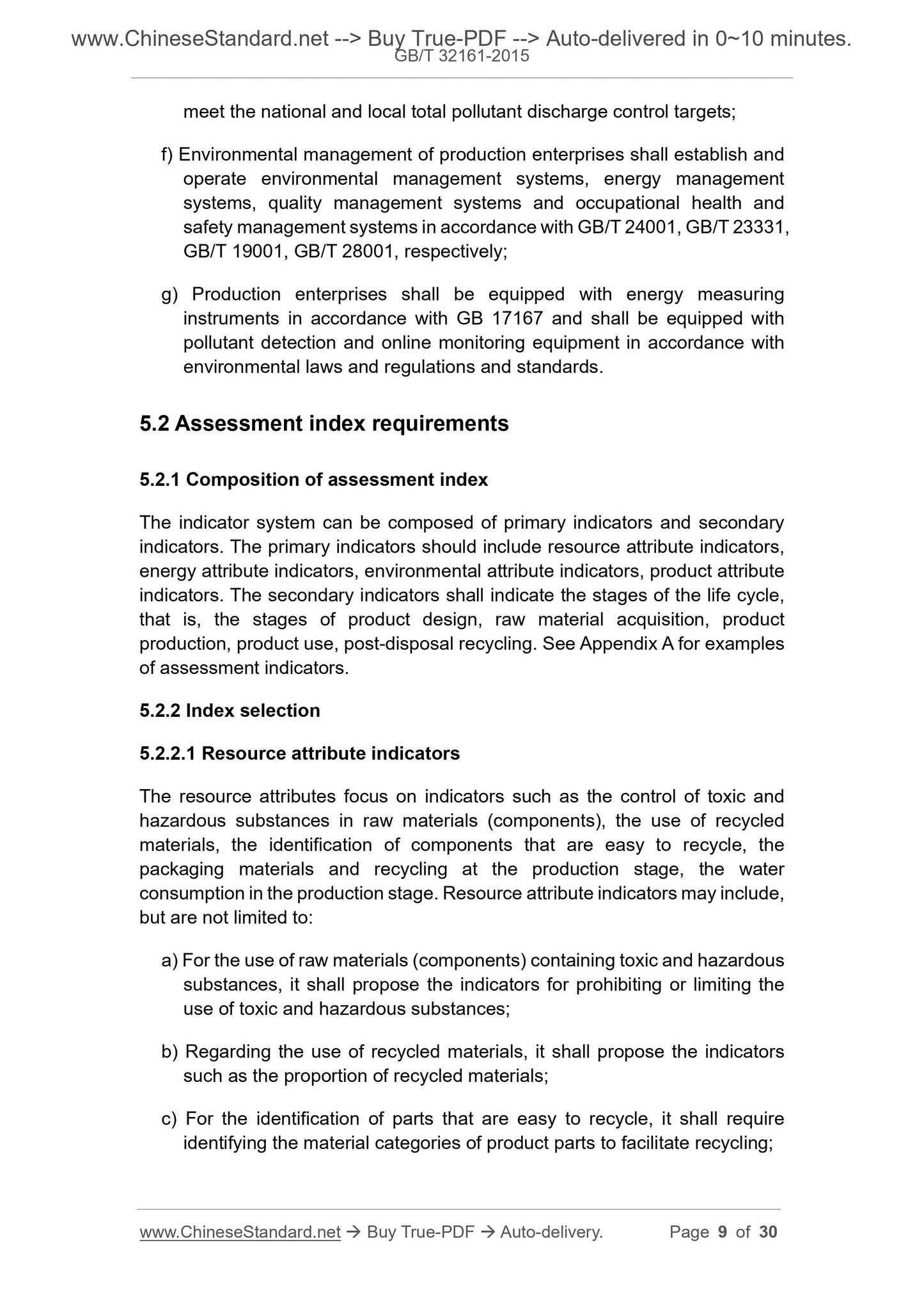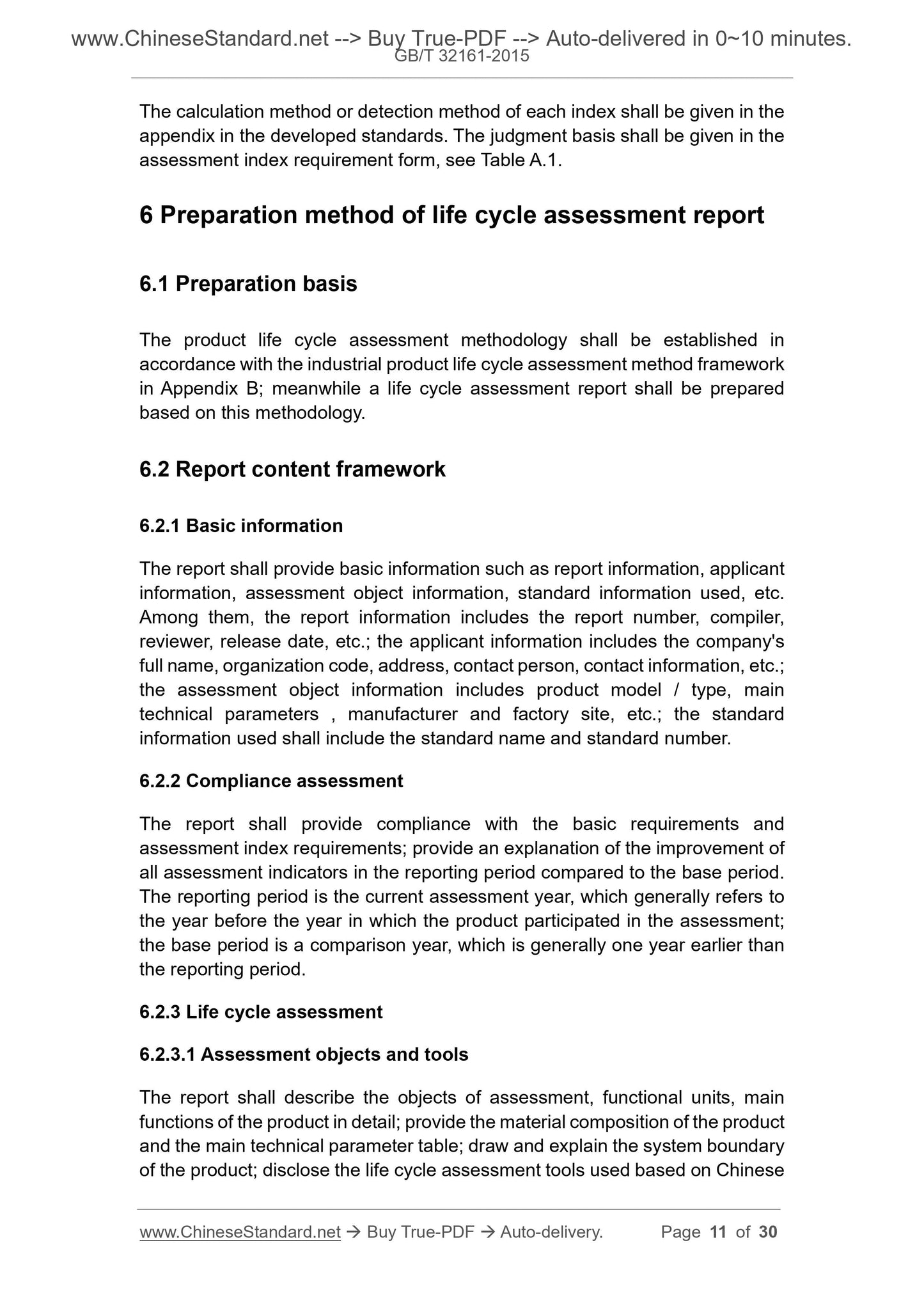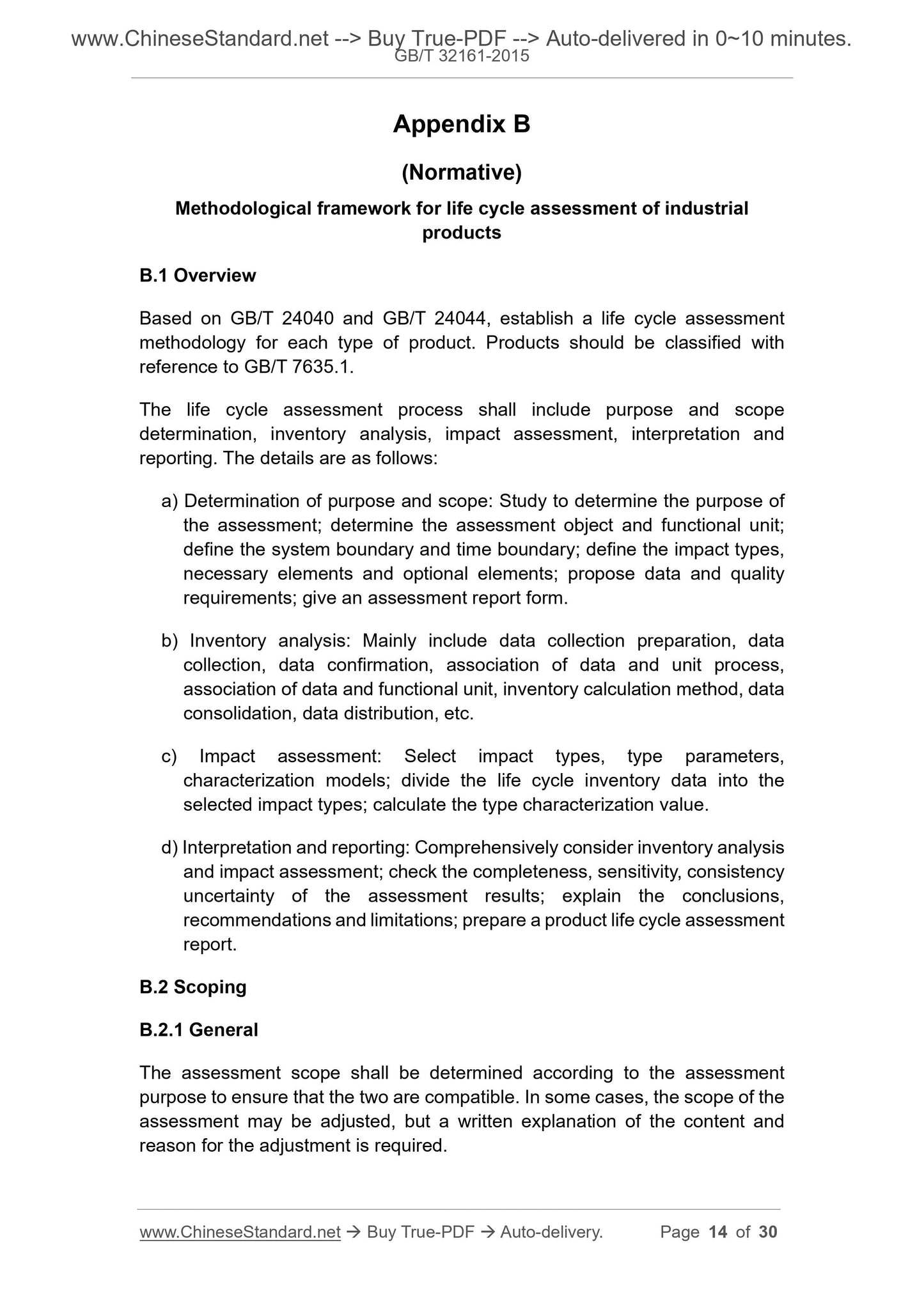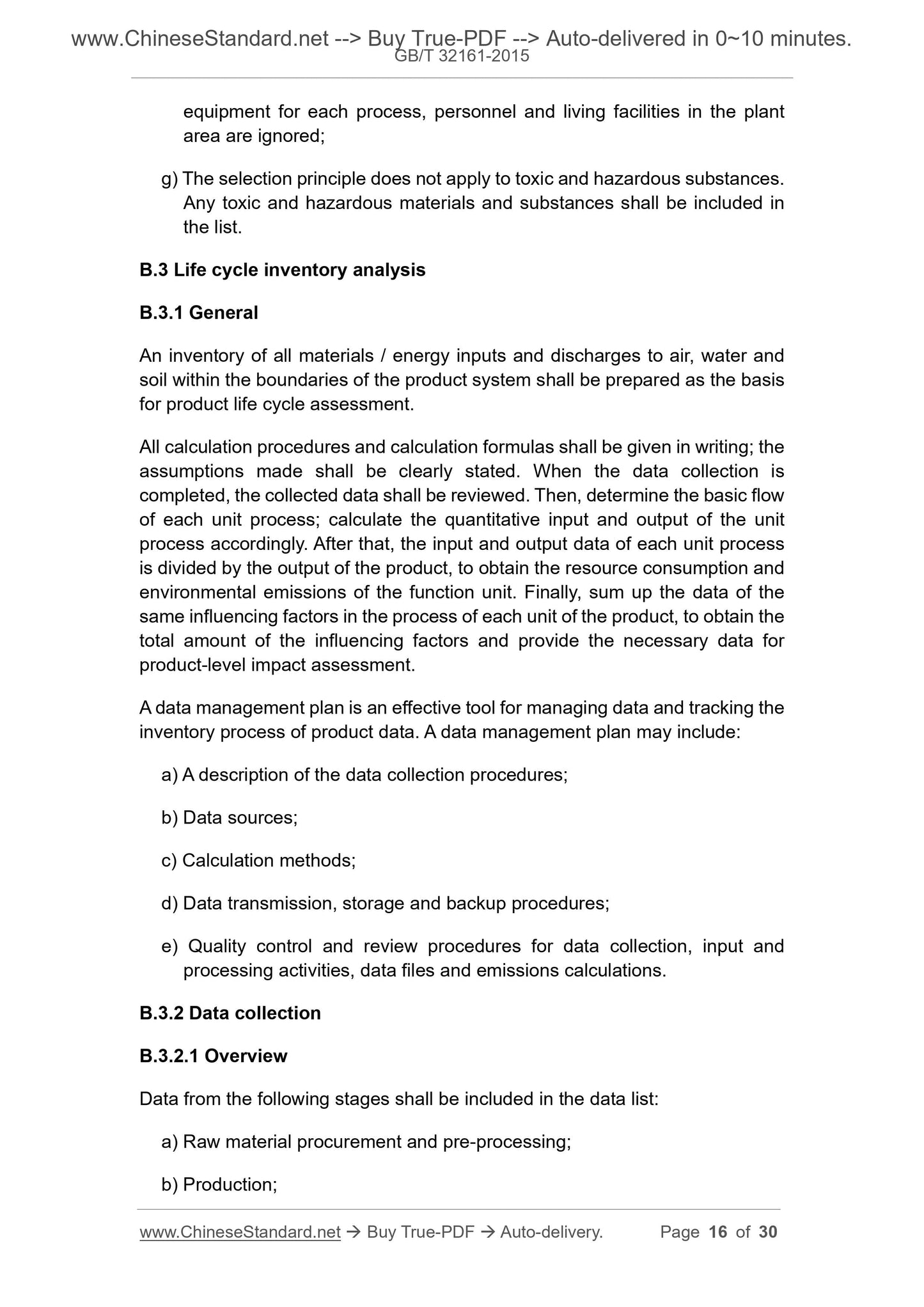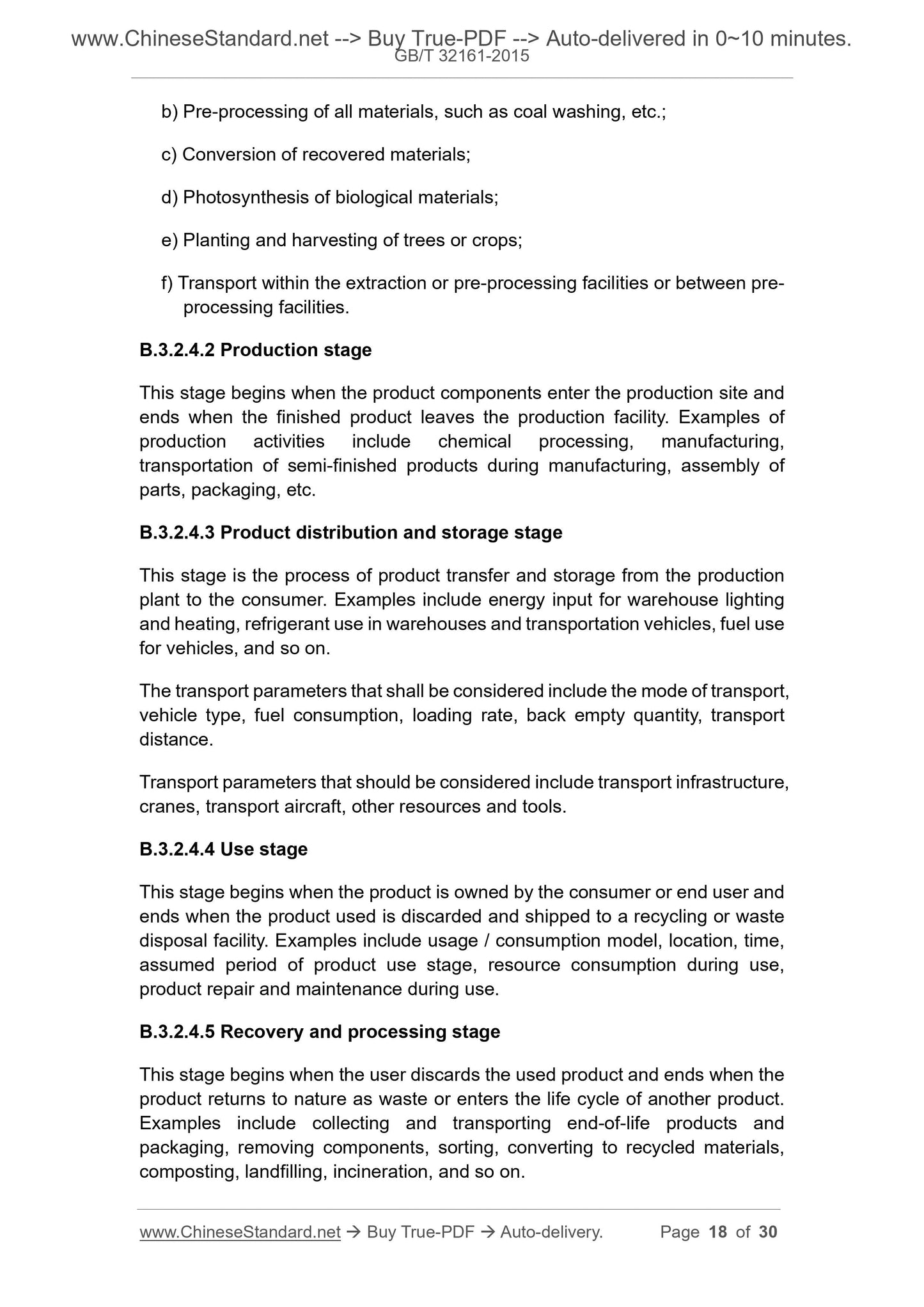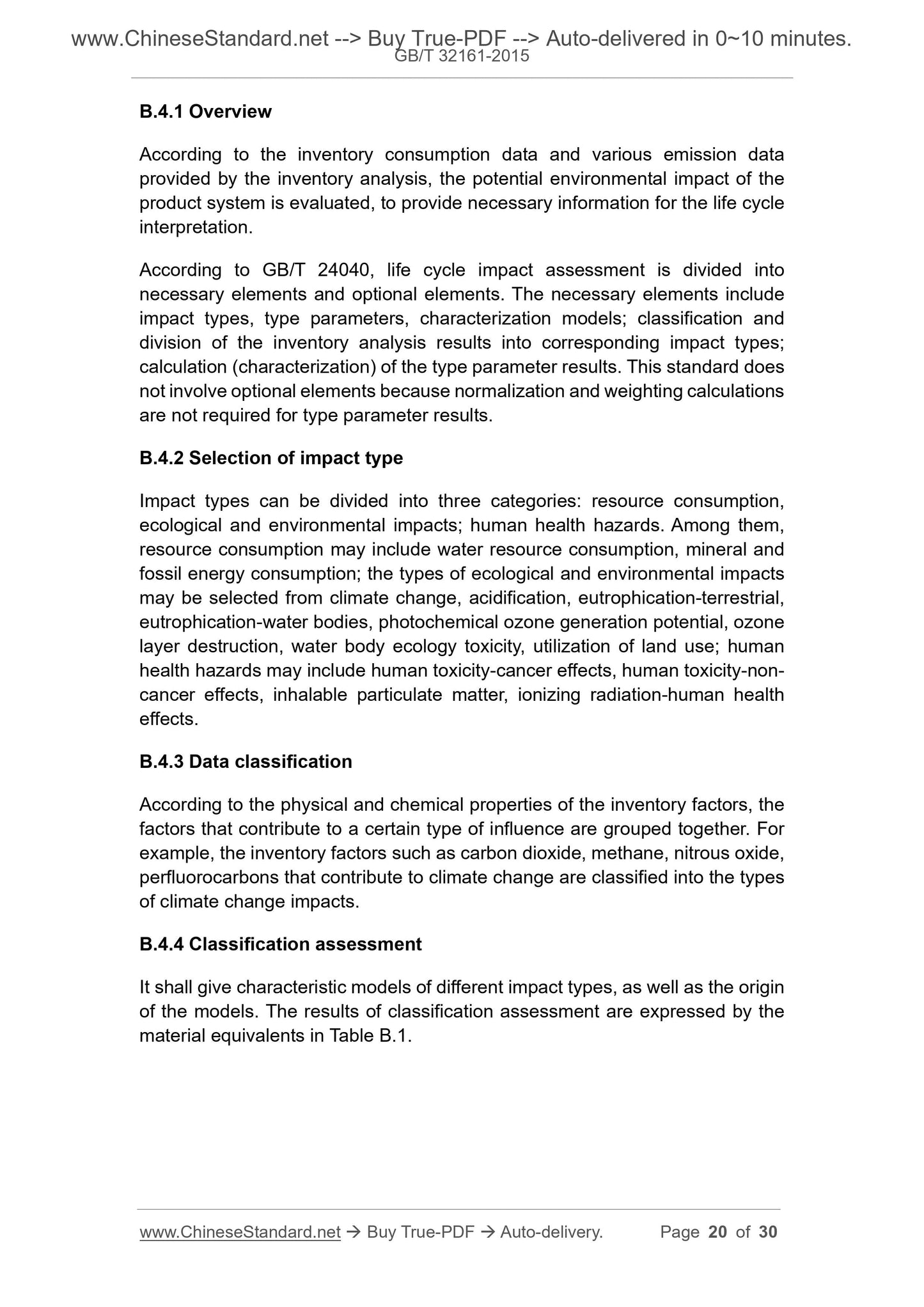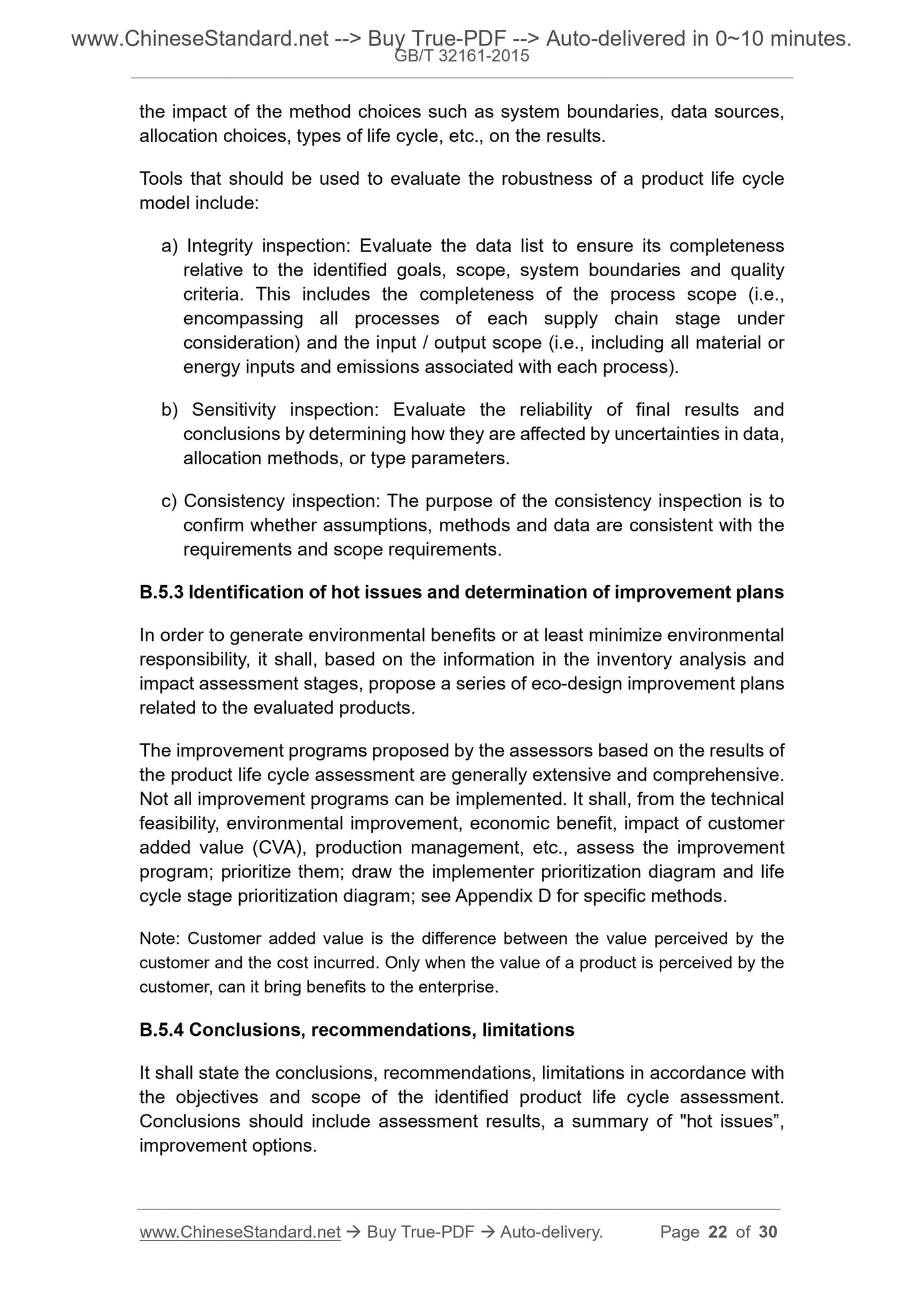1
/
of
11
PayPal, credit cards. Download editable-PDF and invoice in 1 second!
GB/T 32161-2015 English PDF (GB/T32161-2015)
GB/T 32161-2015 English PDF (GB/T32161-2015)
Regular price
$230.00 USD
Regular price
Sale price
$230.00 USD
Unit price
/
per
Shipping calculated at checkout.
Couldn't load pickup availability
Delivery: 3 seconds. Download true-PDF + Invoice.
Get QUOTATION in 1-minute: Click GB/T 32161-2015
Historical versions: GB/T 32161-2015
Preview True-PDF (Reload/Scroll if blank)
GB/T 32161-2015: General principles for eco-design product assessment
GB/T 32161-2015
NATIONAL STANDARD OF THE
PEOPLE’S REPUBLIC OF CHINA
ICS 13.020.20
Z 04
General principles for eco-design product assessment
ISSUED ON: OCTOBER 13, 2015
IMPLEMENTED ON: MAY 01, 2016
Issued by: General Administration of Quality Supervision, Inspection and
Quarantine;
Standardization Administration of PRC.
Table of Contents
Foreword ... 3
1 Scope ... 4
2 Normative references ... 4
3 Terms and definitions ... 5
4 Assessment principles and methods ... 6
4.1 Assessment principles ... 6
4.2 Assessment methods and processes ... 7
5 Assessment requirements ... 8
5.1 Basic requirements ... 8
5.2 Assessment index requirements ... 9
6 Preparation method of life cycle assessment report ... 11
6.1 Preparation basis ... 11
6.2 Report content framework ... 11
Appendix A (Normative) Content framework of eco-design product assessment
specifications ... 13
Appendix B (Normative) Methodological framework for life cycle assessment of
industrial products ... 14
Appendix C (Informative) Example of data collection form ... 23
Appendix D (Informative) Priority ranking methods and examples of
improvement program of product eco-design ... 26
References ... 30
General principles for eco-design product assessment
1 Scope
This standard specifies the terms and definitions, assessment principles and
methods, assessment requirements, methods for preparing life cycle
assessment reports of eco-design product assessment.
This standard applies to the compilation of specifications of specific eco-design
product assessment.
2 Normative references
The following documents are essential to the application of this document. For
the dated documents, only the versions with the dates indicated are applicable
to this document; for the undated documents, only the latest version (including
all the amendments) are applicable to this standard.
GB/T 7635.1 National central product classification and codes - Part 1:
Transportable product
GB17167 General principle for equipping and managing of the measuring
instrument of energy in organization of energy using
GB/T 19001 Quality management systems - Requirements
GB/T 23331 Energy management systems - Requirements
GB/T 24001 Environmental management systems - Requirements with
guidance for use
GB/T 24040 Environmental management - Life cycle assessment -
Principles and frameworks
GB/T 24044 Environmental management - Life cycle assessment -
Requirements and guidelines
GB/T 28001 Occupational health and safety management systems -
Requirements
3.6
Background data
Product’s lifecycle data obtained from sources other than direct
measurements.
3.7
Report for life cycle assessment
A report prepared based on the life cycle assessment method for disclosing
the eco-design of the product and the full life cycle environmental impact
information.
4 Assessment principles and methods
4.1 Assessment principles
4.1.1 Principle of combining life cycle assessment and index assessment
According to the life cycle assessment method, consider the whole life cycle of
industrial products, from the stages of product design, raw material acquisition,
product production, product use, post-disposal recycling, etc., to in-depth
analyze the resource consumption, ecological environment, human health
impact factors at each stage, to select evaluable indicators at different stages
to constitute an assessment index system. Different types of products shall
establish different eco-design assessment index systems, as the access
conditions for evaluating and screening eco-design products. On the basis of
meeting the assessment index requirements, use a life cycle assessment
method to carry out a life cycle inventory analysis, conduct a life cycle impact
assessment, compile a life cycle assessment report, which serves as a
necessary condition for evaluating eco-design products.
4.1.2 Principles for optimal selection of environmental impact types
In order to reduce the difficulty of life cycle assessment, according to the
characteristics of the product, it should select the types of environmental
impacts with high impact, high social attention, clear requirements of national
laws or policies. Usually, they can be selected in climate change, ozone layer
destruction, water body ecological toxicity, human body toxicity-cancer effect,
human toxicity-non-cancer effect, respirable particulate matter, ionizing
radiation-human health effect, photochemical ozone generation potential,
acidification, eutrophication-terrestrial, eutrophication-water body, water
consumption, minerals and fossils energy consumption, land use change and
meet the national and local total pollutant discharge control targets;
f) Environmental management of production enterprises shall establish and
operate environmental management systems, energy management
systems, quality management systems and occupational health and
safety management systems in accordance with GB/T 24001, GB/T 23331,
GB/T 19001, GB/T 28001, respectively;
g) Production enterprises shall be equipped with energy measuring
instruments in accordance with GB 17167 and shall be equipped with
pollutant detection and online monitoring equipment in accordance with
environmental laws and regulations and standards.
5.2 Assessment index requirements
5.2.1 Composition of assessment index
The indicator system can be composed of primary indicators and secondary
indicators. The primary indicators should include resource attribute indicators,
energy attribute indicators, environmental attribute indicators, product attribute
indicators. The secondary indicators shall indicate the stages of the life cycle,
that is, the stages of product design, raw material acquisition, product
production, product use, post-disposal recycling. See Appendix A for examples
of assessment indicators.
5.2.2 Index selection
5.2.2.1 Resource attribute indicators
The resource attributes focus on indicators such as the control of toxic and
hazardous substances in raw materials (components), the use of recycled
materials, the identification of components that are easy to recycle, the
packaging materials and recycling at the production stage, the water
consumption in the production stage. Resource attribute indicators may include,
but are not limited to:
a) For the use of raw materials (components) containing toxic and hazardous
substances, it shall propose the indicators for prohibiting or limiting the
use of toxic and hazardous substances;
b) Regarding the use of recycled materials, it shall propose the indicators
such as the proportion of recycled materials;
c) For the identification of parts that are easy to recycle, it shall require
identifying the material categories of product parts to facilitate recycling;
The calculation method or detection method of each index shall be given in the
appendix in the developed standards. The judgment basis shall be given in the
assessment index requirement form, see Table A.1.
6 Preparation method of life cycle assessment report
6.1 Preparation basis
The product life cycle assessment methodology shall be established in
accordance with the industrial product life cycle assessment method framework
in Appendix B; meanwhile a life cycle assessment report shall be prepared
based on this methodology.
6.2 Report content framework
6.2.1 Basic information
The ...
Get QUOTATION in 1-minute: Click GB/T 32161-2015
Historical versions: GB/T 32161-2015
Preview True-PDF (Reload/Scroll if blank)
GB/T 32161-2015: General principles for eco-design product assessment
GB/T 32161-2015
NATIONAL STANDARD OF THE
PEOPLE’S REPUBLIC OF CHINA
ICS 13.020.20
Z 04
General principles for eco-design product assessment
ISSUED ON: OCTOBER 13, 2015
IMPLEMENTED ON: MAY 01, 2016
Issued by: General Administration of Quality Supervision, Inspection and
Quarantine;
Standardization Administration of PRC.
Table of Contents
Foreword ... 3
1 Scope ... 4
2 Normative references ... 4
3 Terms and definitions ... 5
4 Assessment principles and methods ... 6
4.1 Assessment principles ... 6
4.2 Assessment methods and processes ... 7
5 Assessment requirements ... 8
5.1 Basic requirements ... 8
5.2 Assessment index requirements ... 9
6 Preparation method of life cycle assessment report ... 11
6.1 Preparation basis ... 11
6.2 Report content framework ... 11
Appendix A (Normative) Content framework of eco-design product assessment
specifications ... 13
Appendix B (Normative) Methodological framework for life cycle assessment of
industrial products ... 14
Appendix C (Informative) Example of data collection form ... 23
Appendix D (Informative) Priority ranking methods and examples of
improvement program of product eco-design ... 26
References ... 30
General principles for eco-design product assessment
1 Scope
This standard specifies the terms and definitions, assessment principles and
methods, assessment requirements, methods for preparing life cycle
assessment reports of eco-design product assessment.
This standard applies to the compilation of specifications of specific eco-design
product assessment.
2 Normative references
The following documents are essential to the application of this document. For
the dated documents, only the versions with the dates indicated are applicable
to this document; for the undated documents, only the latest version (including
all the amendments) are applicable to this standard.
GB/T 7635.1 National central product classification and codes - Part 1:
Transportable product
GB17167 General principle for equipping and managing of the measuring
instrument of energy in organization of energy using
GB/T 19001 Quality management systems - Requirements
GB/T 23331 Energy management systems - Requirements
GB/T 24001 Environmental management systems - Requirements with
guidance for use
GB/T 24040 Environmental management - Life cycle assessment -
Principles and frameworks
GB/T 24044 Environmental management - Life cycle assessment -
Requirements and guidelines
GB/T 28001 Occupational health and safety management systems -
Requirements
3.6
Background data
Product’s lifecycle data obtained from sources other than direct
measurements.
3.7
Report for life cycle assessment
A report prepared based on the life cycle assessment method for disclosing
the eco-design of the product and the full life cycle environmental impact
information.
4 Assessment principles and methods
4.1 Assessment principles
4.1.1 Principle of combining life cycle assessment and index assessment
According to the life cycle assessment method, consider the whole life cycle of
industrial products, from the stages of product design, raw material acquisition,
product production, product use, post-disposal recycling, etc., to in-depth
analyze the resource consumption, ecological environment, human health
impact factors at each stage, to select evaluable indicators at different stages
to constitute an assessment index system. Different types of products shall
establish different eco-design assessment index systems, as the access
conditions for evaluating and screening eco-design products. On the basis of
meeting the assessment index requirements, use a life cycle assessment
method to carry out a life cycle inventory analysis, conduct a life cycle impact
assessment, compile a life cycle assessment report, which serves as a
necessary condition for evaluating eco-design products.
4.1.2 Principles for optimal selection of environmental impact types
In order to reduce the difficulty of life cycle assessment, according to the
characteristics of the product, it should select the types of environmental
impacts with high impact, high social attention, clear requirements of national
laws or policies. Usually, they can be selected in climate change, ozone layer
destruction, water body ecological toxicity, human body toxicity-cancer effect,
human toxicity-non-cancer effect, respirable particulate matter, ionizing
radiation-human health effect, photochemical ozone generation potential,
acidification, eutrophication-terrestrial, eutrophication-water body, water
consumption, minerals and fossils energy consumption, land use change and
meet the national and local total pollutant discharge control targets;
f) Environmental management of production enterprises shall establish and
operate environmental management systems, energy management
systems, quality management systems and occupational health and
safety management systems in accordance with GB/T 24001, GB/T 23331,
GB/T 19001, GB/T 28001, respectively;
g) Production enterprises shall be equipped with energy measuring
instruments in accordance with GB 17167 and shall be equipped with
pollutant detection and online monitoring equipment in accordance with
environmental laws and regulations and standards.
5.2 Assessment index requirements
5.2.1 Composition of assessment index
The indicator system can be composed of primary indicators and secondary
indicators. The primary indicators should include resource attribute indicators,
energy attribute indicators, environmental attribute indicators, product attribute
indicators. The secondary indicators shall indicate the stages of the life cycle,
that is, the stages of product design, raw material acquisition, product
production, product use, post-disposal recycling. See Appendix A for examples
of assessment indicators.
5.2.2 Index selection
5.2.2.1 Resource attribute indicators
The resource attributes focus on indicators such as the control of toxic and
hazardous substances in raw materials (components), the use of recycled
materials, the identification of components that are easy to recycle, the
packaging materials and recycling at the production stage, the water
consumption in the production stage. Resource attribute indicators may include,
but are not limited to:
a) For the use of raw materials (components) containing toxic and hazardous
substances, it shall propose the indicators for prohibiting or limiting the
use of toxic and hazardous substances;
b) Regarding the use of recycled materials, it shall propose the indicators
such as the proportion of recycled materials;
c) For the identification of parts that are easy to recycle, it shall require
identifying the material categories of product parts to facilitate recycling;
The calculation method or detection method of each index shall be given in the
appendix in the developed standards. The judgment basis shall be given in the
assessment index requirement form, see Table A.1.
6 Preparation method of life cycle assessment report
6.1 Preparation basis
The product life cycle assessment methodology shall be established in
accordance with the industrial product life cycle assessment method framework
in Appendix B; meanwhile a life cycle assessment report shall be prepared
based on this methodology.
6.2 Report content framework
6.2.1 Basic information
The ...
Share
